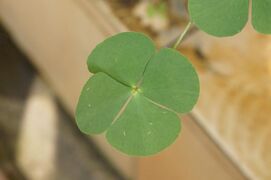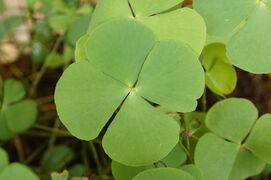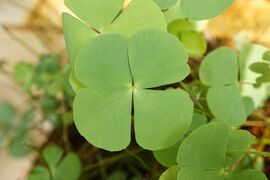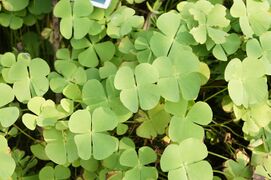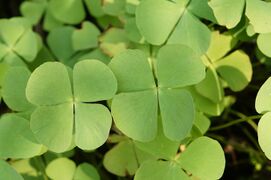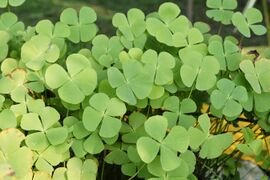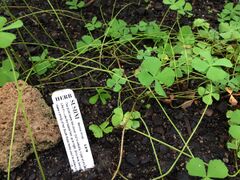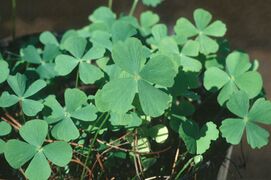Biology:Marsilea minuta
| Marsilea minuta | |
|---|---|
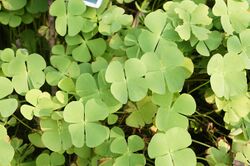
| |
| Marsilea minuta | |
| Scientific classification | |
| Kingdom: | Plantae |
| Clade: | Tracheophytes |
| Division: | Polypodiophyta |
| Class: | Polypodiopsida |
| Order: | Salviniales |
| Family: | Marsileaceae |
| Genus: | Marsilea |
| Species: | M. minuta
|
| Binomial name | |
| Marsilea minuta | |
| Subspecies | |
| |
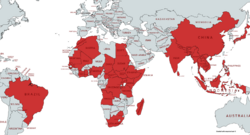
| |
| Native range of Marsilea minuta[1][4] | |
| Synonyms[2] | |
|
List
| |
Marsilea minuta, or dwarf waterclover is a species of aquatic fern in the family Marsileaceae. It is not to be confused with Marsilea minuta E.Fourn. 1880, which is a synonym for Marsilea vestita.[4] Other common names include gelid waterklawer, small water clover,[1] airy pepperwort, and pepperwort,[7] though the lattermost also applies to plants in the genus Lepidium. In French it is called marsilea à quatre feuilles (literally "four-leafed marsilea")[7] and petite marsilée (literally "little Marsilea"),[1] the latter appearing to be a calque with the Latin botanical name. In Chinese it is 南国田字草 (nan guo tian zi cao),[8] literally "southern field word grass," referencing the similarity of the leaflet shape to the Chinese character for "field." The Koch Rajbongshi people and Garo people call it shusni shak.[9] It is called 'শুশনি শাক' ('shushni shak') in Bengali . In parts of India it can be called sunisanakka[10] In Indonesian it is semanggi (literally "clover"),[7] but this name also applies to Marsilea crenata. In Japanese it is nangokudenjiso and in Thai it is phakwaen.[7] In Malaysian it is tapak itik (literally "duck footprints").[7] In the Philippines it is kaya-kayapuan (literally "so crowded").[7]
Description
M. minuta has a strongly variable appearance,[5] which often leads to confusion with closely related species. In the water the plant is creeping and spreading, while on land it can appear cushion-like.[5] It typically is perennial but sometimes appears annual. It is a tenagophyte, with the juvenile growing submerged and the adult typically terrestrial.[5]
It has a light brown to green rhizome that is 0.4–0.8 millimetres (1⁄64–1⁄32 in) thick with short tan hairs at the ends and internodal roots.[4] The land leaves are on erect, terete, 5–13 centimetres (2.0–5.1 in) long petioles.[4] The leaflets are 0.8–1.7 centimetres (3⁄8–5⁄8 in) by 1.2–2 centimetres (1⁄2–3⁄4 in), mostly glabrous, cuneate or flabellate.[4] The leaves in water are typically not floating, but emergent from the water.[4] Fertile leaves are produced on land with up to four sporocarps each at penduncles near the base of the petiole.[4] It has a small sporocarp that is 2.6–4.1 millimetres (7⁄64–5⁄32 in) long, 2.4–3.1 millimetres (3⁄32–1⁄8 in) wide, and 1.3–1.7 millimetres (3⁄64–1⁄16 in) thick.[4][11] The sporocarp has a superior tooth at the apex of the stalk and an inferior tooth at the base.[12][5] The sporocarp has a conspicuous 1.5–2.2 millimetres (1⁄16–3⁄32 in) long raphe,[4][12] about ⅔ the length of the sporocarp and semi-terete.[5] Unlike a few Marsilea species, M. minuta sporocarps mature above ground.[12]
| Ploidy | diploid[13] |
|---|---|
| Number of chromosomes | 40[13] |
Taxonomy
M. minuta is thought to be closely related to Marsilea quadrifolia.[4] Molecular phylogenetic analysis of the genus Marsilea puts both in a widespread Old World subgroup also called "Marsilea" along with M. angustifolia, M. drummondii, M. crenata, and M. fadeniana and indicating that M. crenata is actually a synonym of M. minuta.[12][7]
| Marsilea subgroup |
| ||||||||||||||||||||||||||||||||||||||||||||||||
Habitat and ecology
Marsilea minuta can grow from sea level up to 1,950m in elevation[1] in ponds and other shallow water.[8] It can grow in fresh water or brackish water in clay or sandy soil.[4] The plant can develop into large colonies, and can be weedy.[4][11] Some of its preferred habitat is being lost to agriculture but as it readily grows in Paddy fields, drainage ditches, and other marginal areas its overall population is stable.[1] It has the potential to be invasive and dispersal through aquarium trade and other human means should be limited.[7]
It is a native plant in the following countries:[1]
The leaves and sporocarps of M. minuta are eaten by many waterfowl species, and the intact sporocarps pass through undigested to be spread to new areas.[7] Elophila responsalis also feeds on the leaves, but is not thought to do much damage to the plant.[7]
The plant is susceptible to herbicides such as bensulfuron-methyl, cinosulfuron, 2,4-Dichlorophenoxyacetic acid, oxyfluorfen, and paraquat.[7] Otherwise it can tolerate high levels of organic pollution.[5]
Uses
It is eaten in India , Sri Lanka,[14] and in Bangladesh.[9] In China it is used as forage.[8] It has a raw protein content of 3.3%.[14]
The plant is used traditionally in China for edema, skin injuries, snakebite, and inflammation.[8] In Mymensingh District it is traditionally used to treat cough, headache, hypertension, sleep disorders, and respiratory diseases.[9] It is combined with Nardostachys jatamansi and after development by Asima Chatterjee[15] sold as an ayurvedic treatment for epilepsy called "Ayush-56."[10] However, Ayush-56 does not show encouraging results in treating the disease.[16] It is also used as a phytoremediator of arsenic while growing with rice plants.[17][18]
Gallery
References
- ↑ 1.0 1.1 1.2 1.3 1.4 1.5 1.6 1.7 1.8 Beentje, H.J.; Lansdown, R.V. (2019). "Marsilea minuta". IUCN Red List of Threatened Species 2019: e.T164326A120212467. doi:10.2305/IUCN.UK.2019-2.RLTS.T164326A120212467.en. https://www.iucnredlist.org/species/164326/120212467. Retrieved 19 November 2021.
- ↑ 2.00 2.01 2.02 2.03 2.04 2.05 2.06 2.07 2.08 2.09 2.10 "Marsilea minuta L. — The Plant List" (in English). 2012. http://www.theplantlist.org/tpl1.1/record/tro-26604296.
- ↑ 3.00 3.01 3.02 3.03 3.04 3.05 3.06 3.07 3.08 3.09 3.10 3.11 3.12 3.13 3.14 3.15 3.16 3.17 3.18 3.19 3.20 3.21 3.22 3.23 3.24 3.25 3.26 3.27 3.28 3.29 3.30 3.31 3.32 3.33 Marsilea minuta L. in GBIF Secretariat (2016). GBIF Backbone Taxonomy. Checklist Dataset https://doi.org/10.15468/39omei https://www.gbif.org/species/5274876 accessed via GBIF.org on 2017-09-20.
- ↑ 4.00 4.01 4.02 4.03 4.04 4.05 4.06 4.07 4.08 4.09 4.10 4.11 4.12 4.13 Johnson, David M. (25 June 1986) (in English). Systematics of the New World Species of Marsilea (Marsileaceae). 11. Ann Arbor, MI: The American Society of Plant Taxonomists. 39–40, 51, 63. doi:10.2307/25027626. ISBN 978-0912861111. OCLC 13455360.
- ↑ 5.00 5.01 5.02 5.03 5.04 5.05 5.06 5.07 5.08 5.09 5.10 Cook, Christopher D. K. (28 March 1996). "Cyperaceae" (in English). Aquatic and Wetland Plants of India: a reference book and identification manual for the vascular plants found in permanent or seasonal fresh water in the subcontinent of India south of the Himalayas. New York, NY: Oxford University Press. p. 105. ISBN 9780198548218. OCLC 32968513.
- ↑ Marsilea minuta L. in GBIF Secretariat (2016). GBIF Backbone Taxonomy. Checklist Dataset https://doi.org/10.15468/39omei accessed via GBIF.org on 2017-09-17
- ↑ 7.00 7.01 7.02 7.03 7.04 7.05 7.06 7.07 7.08 7.09 7.10 "Marsilea minuta (pepperwort)" (in English). Wallingford, UK: CAB International. 15 May 2008. http://www.cabi.org/isc/datasheet/32557.
- ↑ 8.0 8.1 8.2 8.3 Lin, Y. X.; Johnson, D. M. (6 June 2013). Wu, Z. Y.; Raven, P. H.; Hong, D. Y.. eds. "Marsileaceae" (in English). Flora of China 2-3: 123–124. http://flora.huh.harvard.edu/china/mss/volume02/Flora_of_China_Volume_2_3_Marsileaceae.pdf. Retrieved 25 August 2017.
- ↑ 9.0 9.1 9.2 Sarker, Sujan Kumer; Hossain, A.B.M. Enayet (June 2009). "Pteridophytes of Greater Mymensingh District of Bangladesh used as Vegetables and Medicines" (in English). Bangladesh Journal of Plant Taxonomy 16 (1): 54. doi:10.3329/bjpt.v16i1.2746. ISSN 2224-7297.
- ↑ 10.0 10.1 Krishnamoorthy, Ennapadam S.; Shorvon, Simon; Schachter, Steven et al., eds (6 April 2017). "34 Ayurveda and Yoga in the Management of Epilepsy" (in English). Epilepsy: A Global Approach. Cambridge University Press. p. 160. doi:10.1017/9781139547918. ISBN 9781108232159. https://books.google.com/books?id=J_OkDgAAQBAJ&q=marislea&pg=PA160. Retrieved 29 August 2017.
- ↑ 11.0 11.1 Schelpe, E. A. C. L. E. (1970). "eFloras Results For Marsilea minuta" (in English). Royal Botanic Gardens, Kew. http://apps.kew.org/efloras/namedetail.do?qry=namelist&flora=fz&taxon=7540&nameid=18883.
- ↑ 12.0 12.1 12.2 12.3 Nagalingum, Nathalie S.; Schneider, Harald; Pryer, Kathleen M. (2007). "Molecular Phylogenetic Relationships and Morphological Evolution in the Heterosporous Fern Genus Marsilea" (in English). Systematic Botany 32 (1): 16–25. doi:10.1600/036364407780360256. ISSN 1548-2324.
- ↑ 13.0 13.1 Srivastava, R. B. (1985). "Ferns of the Indo-Nepal border" (in English). Proceedings of the Royal Society of Edinburgh, Section B 86: 471. doi:10.1017/S0269727000008770. ISSN 0269-7270. OCLC 5549574398. "23. M. minuta L. 40 20 2.9-4.6 Diploid".
- ↑ 14.0 14.1 Terra, G.J.A. (1966). "IIID Ferns and Related Plants" (in English). Tropical vegetables: vegetable growing in the tropics and subtropics especially of indigenous vegetables. Communication. 54e (1st ed.). Amsterdam: Koninklijk Instituut voor de Tropen. p. 57. OCLC 9027279. "Marsilea minuta L. (Marsileaceae) I Ce (3.3%)"
- ↑ Basak, Swati (May 2015). "Women, Science, Education And Empowerment: Asima Chatterjee, The Genius Lady". IMPACT: International Journal of Research in Humanities, Arts and Literature 3 (5): 133–138. http://oaji.net/articles/2015/488-1434793998.pdf.
- ↑ Tripathi, M; Maheshwari, MC; Jain, S; Padma, MV (2000). "Ayurvedic Medicine and Epilepsy" (in English). Neurology Journal of Southeast Asia 5: 1–4. http://www.neurology-asia.org/articles/20001_001.pdf. Retrieved 29 August 2017.
- ↑ Hassi, Ummehani; Hossain, Md. Tawhid; Huq, S. M. Imamul (2017-10-10). "Mitigating arsenic contamination in rice plants with an aquatic fern, Marsilea minuta" (in en). Environmental Monitoring and Assessment 189 (11): 550. doi:10.1007/s10661-017-6270-2. ISSN 0167-6369. PMID 29018967.
- ↑ Hassi, U; Hossain, MT; Huq, SMI (2018-07-08). "Nitrogen, phosphorus and potassium status of rice co-planted with a novel phytoremediator, Marsilea minuta L.". Bangladesh Journal of Agricultural Research 43 (2): 211–218. doi:10.3329/bjar.v43i2.37326. ISSN 2408-8293.
External links
Wikidata ☰ Q15249917 entry
 |


